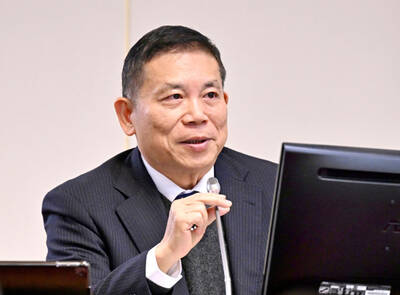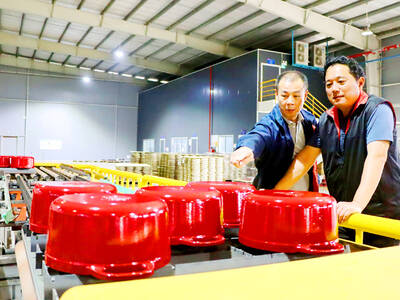Taiwan's first high-speed rail system will not start service at the end of next month as scheduled, as construction of its core mechanical and electrical system has fallen seriously behind schedule, the company managing the project said yesterday.
"We will announce the new timetable after a meticulous evaluation by our board members," said Ted Chia (
At the end of July, THSRC had completed 87.89 percent of the 345km track, 92 percent of station constructions and only 60.44 percent of the core mechanical and electrical system, which has become the major cause for the postponement, Chia said.
The core mechanical and electrical system may be completed only by September next year, according to a Chinese-language newspaper report. In addition, THSRC needs at least two months of trial operation and five months of inspection by the Taiwan High Speed Rail Bureau, under the Ministry of Transportation and Communications. As a result, the high-speed railway may only be launched 18 months after the originally planned date.
While demanding that the Japanese-led Taiwan Shinkansen Corp (TSC, 台灣新幹線) -- contractor for the core mechanical and electrical system's construction -- accelerate production, THSRC also plans to demand that the Japanese consortium abide by the terms of the contract. According to the contract, in the event of falling behind schedule, TSC would have to pay THSRC NT$200 million per day in compensation and to cover interest losses until the construction is completed, a Chinese-language news report said yesterday.
The report also said that TSC has proposed additional terms when THSRC requested it to speed up construction.
The consortium of seven Japanese companies -- Mitsubishi Heavy Industries Ltd, Toshiba Corp, Kawasaki Heavy Industries Ltd, Mitsui & Co, Mitsubishi Corp, Marubeni Corp and Sumitomo Corp -- won the contract for this project in 2000.
The report, citing company supervisor Huang Che-hung (
Chia yesterday confirmed that TSC made additional requests, but said the content of the contract and the terms should remain confidential. Chia declined to comment on the amount of NT$200 million compensation per day, saying the number is merely an estimate touted by the media.
He did not comment on suggestions in the report that the postponement was ultimately the product of a long-standing disagreement between THSRC and TSC over certain technical problems associated with the core mechanical and electrical system. He said that the two companies are negotiating a solution to these problems.
Jack Hsu (許俊逸), a deputy director general of the Bureau of High Speed Rail, said the bureau has not yet received THSRC's formal notice about the postponement. He said the company needs to absorb the losses incurred by the delay itself, since it is a build-operate-transfer project.
According to the contract, THSRC needs to return the transportation facility to the government 35 years after the contract was signed in July 1998, Hsu said.
THSRC previously estimated that it can show ticket revenue of about NT$130 million per day during the initial stages of operation. Since the project has been delayed, it means it will now take longer for the company to break even.
The high-speed railway passed a 200kph test drive at the end of last month and is likely to have a successful 300kph test next month, Chia said.
This project marks the first use of Japan's Shinkansen system outside that country as well as the first time Japanese bullet trains have been exported.

UNCERTAINTY: Innolux activated a stringent supply chain management mechanism, as it did during the COVID-19 pandemic, to ensure optimal inventory levels for customers Flat-panel display makers AUO Corp (友達) and Innolux Corp (群創) yesterday said that about 12 to 20 percent of their display business is at risk of potential US tariffs and that they would relocate production or shipment destinations to mitigate the levies’ effects. US tariffs would have a direct impact of US$200 million on AUO’s revenue, company chairman Paul Peng (彭雙浪) told reporters on the sidelines of the Touch Taiwan trade show in Taipei yesterday. That would make up about 12 percent of the company’s overall revenue. To cope with the tariff uncertainty, AUO plans to allocate its production to manufacturing facilities in

Taiwan will prioritize the development of silicon photonics by taking advantage of its strength in the semiconductor industry to build another shield to protect the local economy, National Development Council (NDC) Minister Paul Liu (劉鏡清) said yesterday. Speaking at a meeting of the legislature’s Economics Committee, Liu said Taiwan already has the artificial intelligence (AI) industry as a shield, after the semiconductor industry, to safeguard the country, and is looking at new unique fields to build more economic shields. While Taiwan will further strengthen its existing shields, over the longer term, the country is determined to focus on such potential segments as

TAKING STOCK: A Taiwanese cookware firm in Vietnam urged customers to assess inventory or place orders early so shipments can reach the US while tariffs are paused Taiwanese businesses in Vietnam are exploring alternatives after the White House imposed a 46 percent import duty on Vietnamese goods, following US President Donald Trump’s announcement of “reciprocal” tariffs on the US’ trading partners. Lo Shih-liang (羅世良), chairman of Brico Industry Co (裕茂工業), a Taiwanese company that manufactures cast iron cookware and stove components in Vietnam, said that more than 40 percent of his business was tied to the US market, describing the constant US policy shifts as an emotional roller coaster. “I work during the day and stay up all night watching the news. I’ve been following US news until 3am

COLLABORATION: Given Taiwan’s key position in global supply chains, the US firm is discussing strategies with local partners and clients to deal with global uncertainties Advanced Micro Devices Inc (AMD) yesterday said it is meeting with local ecosystem partners, including Taiwan Semiconductor Manufacturing Co (TSMC, 台積電), to discuss strategies, including long-term manufacturing, to navigate uncertainties such as US tariffs, as Taiwan occupies an important position in global supply chains. AMD chief executive officer Lisa Su (蘇姿丰) told reporters that Taiwan is an important part of the chip designer’s ecosystem and she is discussing with partners and customers in Taiwan to forge strong collaborations on different areas during this critical period. AMD has just become the first artificial-intelligence (AI) server chip customer of TSMC to utilize its advanced